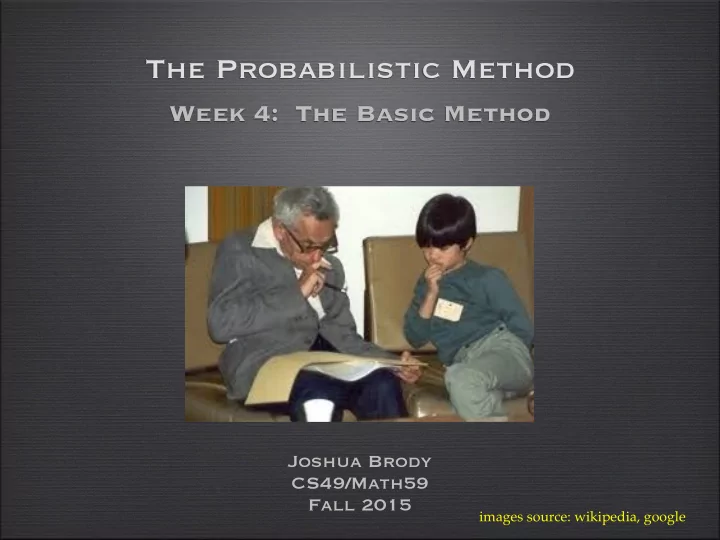

The Probabilistic Method Week 4: The Basic Method Joshua Brody CS49/Math59 Fall 2015 images source: wikipedia, google
Clicker Question What does it mean for a tournament to have property S k ? (A) There is a set of k players that beat all other players. (B) For any set of k players, there is one player that beats them all. (C) There is a set of k players that are all beaten by one player. (D) For any set of k players, there is a player beaten by all of them
Clicker Question What does it mean for a tournament to have property S k ? (A) There is a set of k players that beat all other players. (B) For any set of k players, there is one player that beats them all. (C) There is a set of k players that are all beaten by one player. (D) For any set of k players, there is a player beaten by all of them
Clicker Question Which of the following sets are sum-free? (A) A = {1, 2, 4, 6} (B) B = {17, 19, 35, 47, 101} (C) C = {-14, 22, 57, 71} (D) multiple answers correct (E) no answers correct
Clicker Question Which of the following sets are sum-free? (A) A = {1, 2, 4, 6} (B) B = {17, 19, 35, 47, 101} (C) C = {-14, 22, 57, 71} (D) multiple answers correct (E) no answers correct
Tournaments Definition: A tournament on n players is an orientation of K n (u,v) directed edge: “u beats v”
Property S k Definition: T has property S k if every set of k vertices there is another vertex that beats them all.
Property S k Definition: T has property S k if every set of k vertices there is another vertex that beats them all. Question: Are there always tournaments w/ S k ?
Tournaments with S k n-k ( ) (1-2 -k ) < 1 Theorem: If then there is a tournament n k on n vertices with property S k .
Tournaments with S k n-k ( ) (1-2 -k ) < 1 Theorem: If then there is a tournament n k on n vertices with property S k . Proof: • Choose random tournament on n vertices. • each edge u → v or v → u independently w/prob 1/2 .
Tournaments with S k n-k ( ) (1-2 -k ) < 1 Theorem: If then there is a tournament n k on n vertices with property S k . Proof: • Choose random tournament on n vertices. • each edge u → v or v → u independently w/prob 1/2 . • BAD K : event set of vertices K not dominated by another vertex
Tournaments with S k n-k ( ) (1-2 -k ) < 1 Theorem: If then there is a tournament n k on n vertices with property S k . Proof: • Choose random tournament on n vertices. • each edge u → v or v → u independently w/prob 1/2 . • BAD K : event set of vertices K not dominated by another vertex • BAD := ∪ K BAD K ; • GOOD:= ¬BAD
Clicker Question What is the probability that a set of k vertices does not get dominated? (A) 2 -k (B) (1-2 -k ) (C) 2 -k(n-k) (D) multiple answers possible (E) none of the above
Clicker Question What is the probability that a set of k vertices does not get dominated? (A) 2 -k (B) (1-2 -k ) (C) 2 -k(n-k) (D) multiple answers possible (E) none of the above
Tournaments with S k n-k ( ) (1-2 -k ) < 1 Theorem: If then there is a tournament n k on n vertices with property S k .
Tournaments with S k n-k ( ) (1-2 -k ) < 1 Theorem: If then there is a tournament n k on n vertices with property S k . Proof: • Choose random tournament on n vertices. • each edge u → v or v → u independently w/prob 1/2 . • BAD K : event set of vertices K not dominated by another vertex • BAD := ∪ K BAD K ; GOOD:= ¬BAD
Tournaments with S k n-k ( ) (1-2 -k ) < 1 Theorem: If then there is a tournament n k on n vertices with property S k . Proof: • Choose random tournament on n vertices. • each edge u → v or v → u independently w/prob 1/2 . • BAD K : event set of vertices K not dominated by another vertex • BAD := ∪ K BAD K ; GOOD:= ¬BAD n-k (1-2 -k ) • Pr[BAD k ] = ( ) • # k vertex subsets: n k
Tournaments with S k n-k ( ) (1-2 -k ) < 1 Theorem: If then there is a tournament n k on n vertices with property S k . Proof: • Choose random tournament on n vertices. • each edge u → v or v → u independently w/prob 1/2 . • BAD K : event set of vertices K not dominated by another vertex • BAD := ∪ K BAD K ; GOOD:= ¬BAD n-k (1-2 -k ) union bound: • Pr[BAD k ] = n-k Pr[BAD] ≤ ( ) (1-2 -k ) < 1 n ( ) • # k vertex subsets: n k k
The Probabilistic Method
Recommend
More recommend